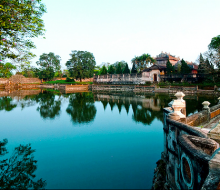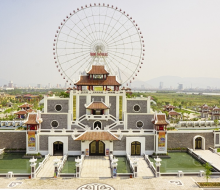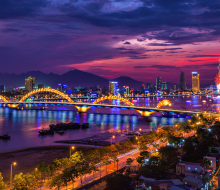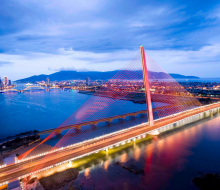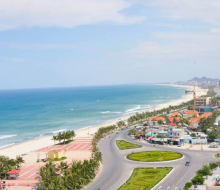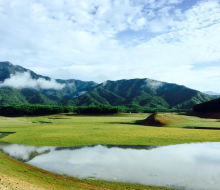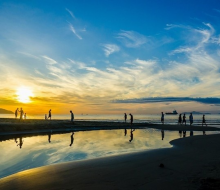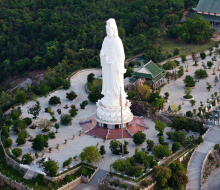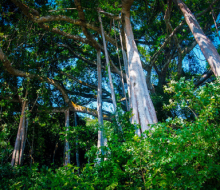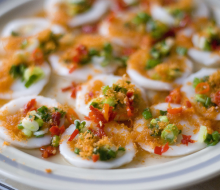The contemplative and ancient look, Imperial nights that illustrate the history of royal life, and sweet songs on Huong River create dreamy and charming Hue.
In comparison with Hoa Lu (Ninh Binh), Co Loa, Thang Long (Ha Noi), Hue Imperial city has been preserved rather well. Hue has a peaceful and silent beauty with many palaces, citadels, temples, tombs, pagodas, and houses with gardens of hundreds year old
.jpg)
Visitors to Hue will have the chance to contemplate masterpieces of art as golden palaces, gorgeous temples, majestic tombs, and peaceful landscapes. Besides, Hue is also known as a hectic city that is perfect for those who want a tranquil but lively destination.
.jpg)
The Imperial city was built under reigns of King Gia Long and King Minh Mang. It is located on the North of Huong River and faces the South. Hue Imperial city is the unique combination of Vietnamese traditional architecture principles, Oriental philosophy with Yin and Yang as well as five element theories, and Western military architectures.
.jpg)
Tombs of the Nguyen emperors comply with Feng Shui principles such as rivers, mountains, lakes, streams. Every royal tomb is divided into two parts: temple and tomb. The tomb area was used to bury the king’s body and the temple one is a place for temple, palace, watching tower, and relaxing place. Therefore, each tomb is not only a historical relic but also a beautiful site among mountains of Hue.
.jpg)
Hue Royal Antiquities Museum was established in 1923 in the Old Citadel with the original name Musee’ Khai Dinh. After that, its name was changed for 5 times. Finally, it was named Hue Royal Antiques Museum in 1993.
There are thousands of artifacts that were made from pottery, wood, copper, falang, stone, bone, ivory, and horn displayed in this Museum.
.jpg)
Hue Royal Festivals were national festivals and held by the state. There had been dozens of different festivals annually organized in this imperial land. These festivals were strictly regulated and even recorded as charters. Therefore, they must be obeyed by everyone. Nowadays, some royal festivals tourists are illustrated in Hue.
Royal music, one of the cultural artistic beauties of Hue, has been recognized as a Masterpiece of the Oral and Intangible Heritage of Humanity. This is the only Oriental Royal Music that has been remained until now. Coming to Hue, tourists can enjoy that special music.
.jpg)
Formerly, this Music was only performed in some important events like coronation, king’s funeral, and other solemn events.
In every Hue Festival, the Old Citadel becomes really sparkling and fanciful by many lights. From the Noon Gate, the main entrance to the Citadel, visitors can see many flags, stately lights and parasols, and soldiers in traditional uniform. This is the setting of the Royal life at night. Visitors may be lost in a fanciful and smoky space with incense fragrance.
In comparison with Hoa Lu (Ninh Binh), Co Loa, Thang Long (Ha Noi), Hue Imperial city has been preserved rather well. Hue has a peaceful and silent beauty with many palaces, citadels, temples, tombs, pagodas, and houses with gardens of hundreds year old
.jpg)
Visitors to Hue will have the chance to contemplate masterpieces of art as golden palaces, gorgeous temples, majestic tombs, and peaceful landscapes. Besides, Hue is also known as a hectic city that is perfect for those who want a tranquil but lively destination.
.jpg)
The Imperial city was built under reigns of King Gia Long and King Minh Mang. It is located on the North of Huong River and faces the South. Hue Imperial city is the unique combination of Vietnamese traditional architecture principles, Oriental philosophy with Yin and Yang as well as five element theories, and Western military architectures.
.jpg)
Tombs of the Nguyen emperors comply with Feng Shui principles such as rivers, mountains, lakes, streams. Every royal tomb is divided into two parts: temple and tomb. The tomb area was used to bury the king’s body and the temple one is a place for temple, palace, watching tower, and relaxing place. Therefore, each tomb is not only a historical relic but also a beautiful site among mountains of Hue.
.jpg)
Hue Royal Antiquities Museum was established in 1923 in the Old Citadel with the original name Musee’ Khai Dinh. After that, its name was changed for 5 times. Finally, it was named Hue Royal Antiques Museum in 1993.
There are thousands of artifacts that were made from pottery, wood, copper, falang, stone, bone, ivory, and horn displayed in this Museum.
.jpg)
Hue Royal Festivals were national festivals and held by the state. There had been dozens of different festivals annually organized in this imperial land. These festivals were strictly regulated and even recorded as charters. Therefore, they must be obeyed by everyone. Nowadays, some royal festivals tourists are illustrated in Hue.
Royal music, one of the cultural artistic beauties of Hue, has been recognized as a Masterpiece of the Oral and Intangible Heritage of Humanity. This is the only Oriental Royal Music that has been remained until now. Coming to Hue, tourists can enjoy that special music.
.jpg)
Formerly, this Music was only performed in some important events like coronation, king’s funeral, and other solemn events.
In every Hue Festival, the Old Citadel becomes really sparkling and fanciful by many lights. From the Noon Gate, the main entrance to the Citadel, visitors can see many flags, stately lights and parasols, and soldiers in traditional uniform. This is the setting of the Royal life at night. Visitors may be lost in a fanciful and smoky space with incense fragrance.
Chia sẻ

